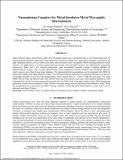Nanoantenna couplers for metal-insulator-metal waveguide interconnects
Author(s)
Onbasli, Mehmet Cengiz; Okyay, Ali K.
DownloadOnbasli-2010-Nanoantenna Couplers for Metal-Insulator-Metal Waveguide Interconnects.pdf (691.4Kb)
PUBLISHER_POLICY
Publisher Policy
Article is made available in accordance with the publisher's policy and may be subject to US copyright law. Please refer to the publisher's site for terms of use.
Terms of use
Metadata
Show full item recordAbstract
State-of-the-art copper interconnects suffer from increasing spatial power dissipation due to chip downscaling and RC delays reducing operation bandwidth. Wide bandwidth, minimized Ohmic loss, deep sub-wavelength confinement and high integration density are key features that make metal-insulator-metal waveguides (MIM) utilizing plasmonic modes attractive for applications in on-chip optical signal processing. Size-mismatch between two fundamental components (micron-size fibers and a few hundred nanometers wide waveguides) demands compact coupling methods for implementation of large scale on-chip optoelectronic device integration. Existing solutions use waveguide tapering, which requires more than 4λ-long taper distances. We demonstrate that nanoantennas can be integrated with MIM for enhancing coupling into MIM plasmonic modes. Two-dimensional finite-difference time domain simulations of antennawaveguide structures for TE and TM incident plane waves ranging from λ = 1300 to 1600 nm were done. The same MIM (100-nm-wide Ag/100-nm-wide SiO2/100-nm-wide Ag) was used for each case, while antenna dimensions were systematically varied. For nanoantennas disconnected from the MIM; field is strongly confined inside MIM-antenna gap region due to Fabry-Perot resonances. Major fraction of incident energy was not transferred into plasmonic modes. When the nanoantennas are connected to the MIM, stronger coupling is observed and E-field intensity at outer end of core is enhanced more than 70 times.
Date issued
2010-08Department
Massachusetts Institute of Technology. Department of Materials Science and EngineeringJournal
Proceedings of SPIE--the International Society for Optical Engineering
Publisher
SPIE--the International Society for Optical Engineering
Citation
Onbasli, M. Cengiz, and Ali K. Okyay. “Nanoantenna Couplers for Metal-insulator-metal Waveguide Interconnects.” Proc. SPIE 7757, Plasmonics: Metallic Nanostructures and Their Optical Properties VIII,(September 10, 2010) Ed. Mark I. Stockman. 2010. 77573R–77573R–11. CrossRef. Web.© (2010) COPYRIGHT SPIE--The International Society for Optical Engineering.
Version: Final published version
ISSN
0277-786X